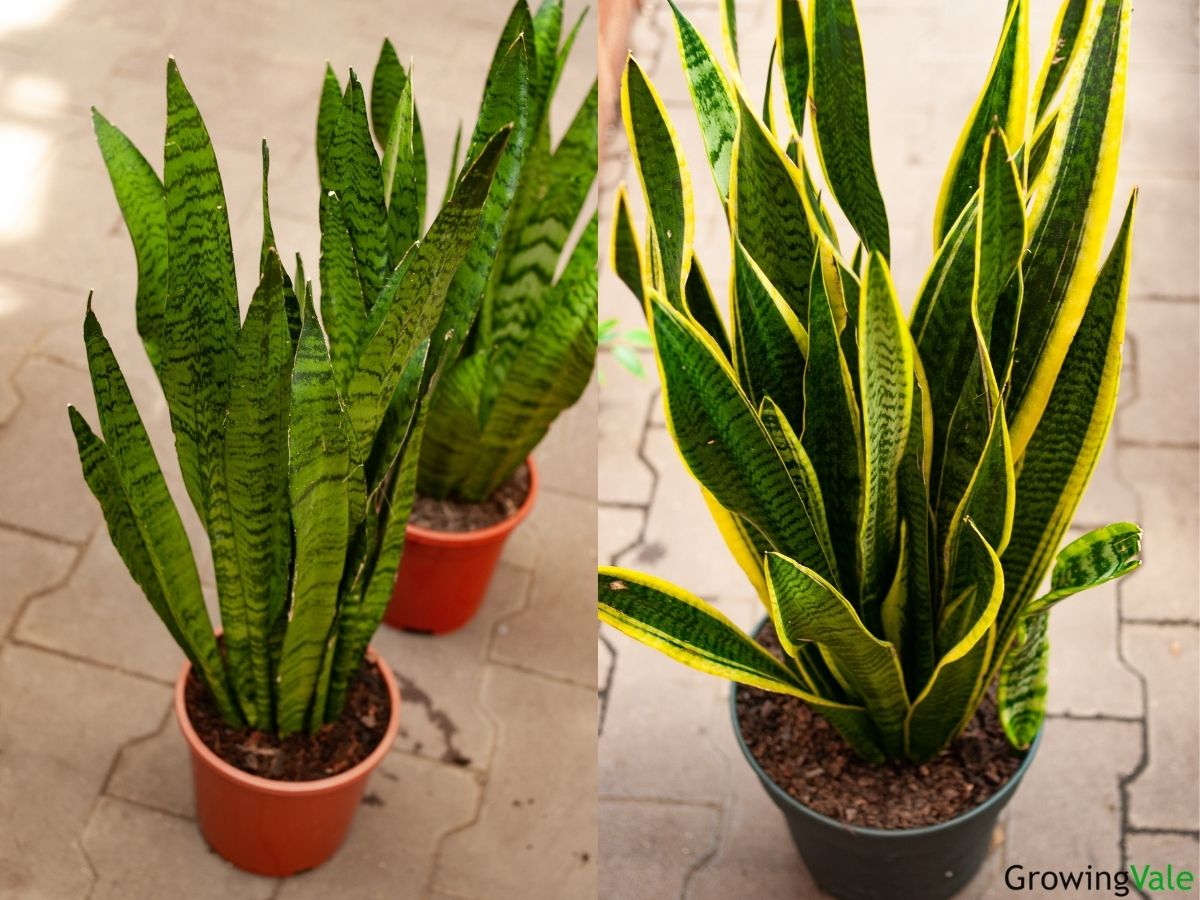Dracaena trifasciata is commonly known as the Snake Plant. It was once classified under Sansevieria, which is still the genus most people are more familiar with. This firm favorite is a perennial, succulent houseplant. It has elegant, patterned leaves, and there are as many as 60 varieties to choose from.
Their pointed, elongated, decorative foliage is extremely sharp to the touch, so be careful! Like the snake itself, snake plants are best admired at a safe distance. Its distinct foliage patterns are said to resemble a snake’s skin.
“Saint George’s Sword” and “Mother-in-law’s Tongue”, the other common names for this plant, refer to the shape of its leaves. One can only assume Saint George’s weapon was as sharp as the foliage, so take care when handling or propagating to not get pricked by the leaves.
Another name for this succulent plant is “Viper’s Bowstring hemp”, referring to both the patterns of the serpent visible on the markings of the leaves and also the use of its leaf fiber for making instrument strings. All the leaves stem from a basal rosette, clustered in a circle of leaf stems. Pinpointing this part is useful when propagating or dividing.
A final name for snake plant, “Jinn’s Tongue”, refers to the Asian djinn or malevolent spirit, who occasionally favors mankind with the odd blessing. Overall, the message of this plant is to admire it from a safe distance, taking care with its dangerous edges!

History of Dracaena trifasciata
Dracaena trifasciata is native to the tropical regions of West Africa, where it grows west of the Congo river. Its addition to homes is believed to ward off evil. The Mother in Law’s Tongue plant is now common in Asia and India, where there is a variety unique to Ceylon.
Much confusion surrounds the spelling of its name in gardening stores, with the previous genus name spelled as either Sanseveria or Sanseviera. Until 2016 in gardening centers, it was known as Sansevieria trifasciata. This name refers to the Italian region of San Severo, where Vicenzo Petagna originally called it Sanseverini in 1787.
Since then, this plant has had a series of name changes and botanical adjustments. It was historically classed as a succulent, a Lily, and an agave. Since 2016, however, it has been part of the Dracaena family.
From the 1920’s, Viper’s Bowstring hemp plants were growing in Florida. In the 1930s, records show that these plants were exported to Europe, where their elegant foliage was adored by plant specialists. In 1948, a US patent was granted to Gustav Banntel of St Louis, for his discovery of S. trifasciata `Laurentii’ and Sylvan Hahn’s `Golden Hahnii’, and was issued a plant patent in 1953.
Nowadays, the Snake plant is exported by several Central American countries and the Caribbean islands due to the low cost of production there. In China, owners of this valuable plant were believed to be granted special favours by the gods. It is considered to represent good luck!
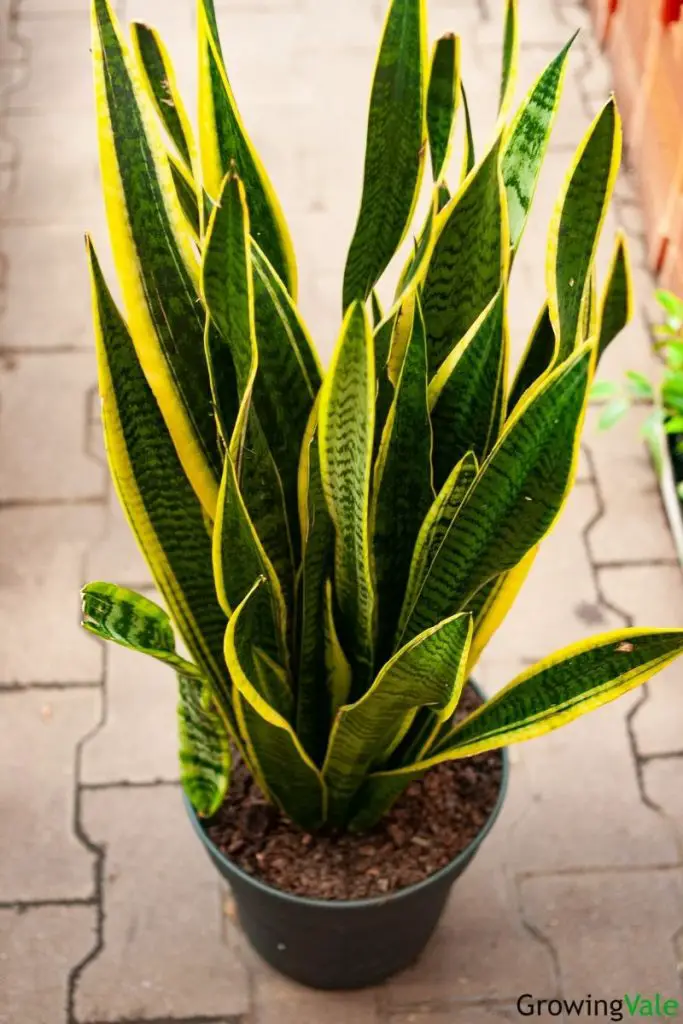
Plant Facts
| Scientific name | Dracaena trifasciata |
| Common names | Mother-in-law’s Tongue, Snake Plant, St. George’s Sword, Viper’s Bowstring hemp, Snake’s Tongue, Jinn’s Tongue. |
| Genus | Dracaena |
| Family | Asparagaceae |
| Height | Up to 2m (6 feet) indoors |
| Width | Leaves: 5–6 centimetres (2.0–2.8 inches) wide |
| USDA Plant Hardiness Zone | 9B – 11 |
| Native to | Tropical West Africa |
| Blooming season | Spring |
| Flower colors | White, cream, or greenish-white |
| Plant specific features | Fruits are orange berries |
How to Plant and Grow Snake Plant
The Snake plant is best grown indoors in a pot. Most rooms will benefit from the clean elegant foliage it offers with green zig-zag patterns to delight the eye. It is a tolerant plant that will grow almost anywhere as long as the soil is well-draining. It thrives in sunny conditions but does not favor direct sunlight because its leaves tend to burn under glass.
Give it lots of love and care in its growing season (spring and summer) during which you will need to water it more often. Feed it once in spring and again in summer. After that, allow the plant to grow dorman. Do not water it as much; once a month should be sufficient.
Mother-in-law’s Tongue plants can grow happily when placed in shaded areas, but a period in the sunshine will improve the color and tone of its leaves. In warmer zones, some gardeners move their plants to the garden in summer, but be warned that it is not frost hardy. At the slightest cold wind, the leaves may turn black.
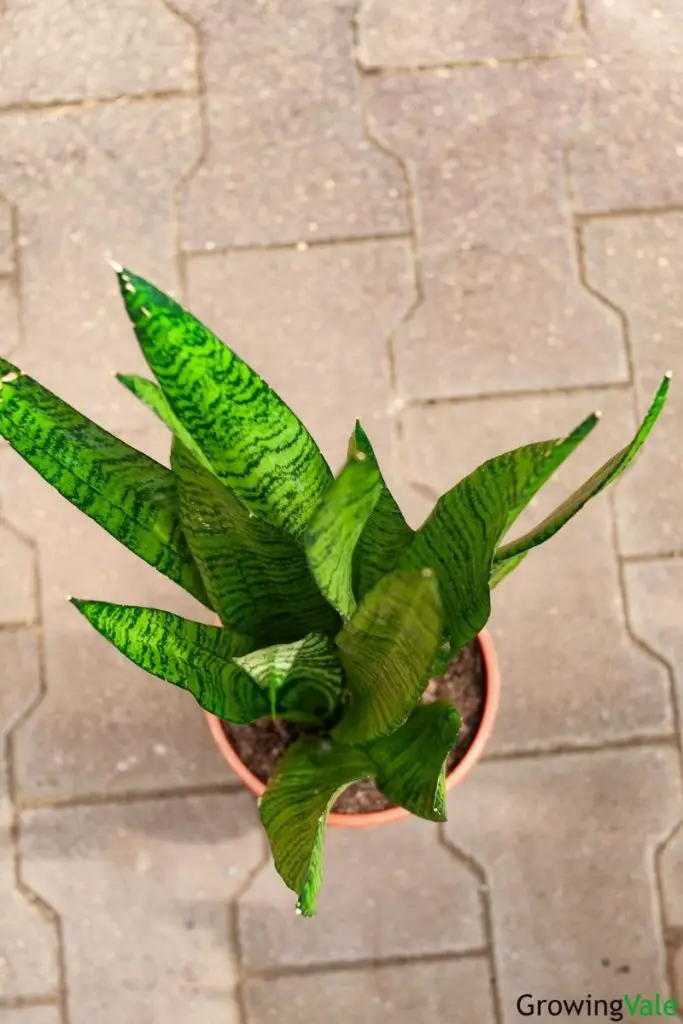
How to Propagate Mother-in-Law’s Tongue
Snake plants are infamous in Florida as an invasive plant. So many have escaped their gardens and have begun to thrive in the wild due to the sunny climate. This highlights the ease with which these plants readily adapt to many situations. Propagation is not difficult and should be easy for beginner gardeners.
Try cutting some leaves with sharp planting shears to cleanly expose the interior tissues. Place these cuttings directly into soil and water them. Within a few weeks, you may spot roots growing.
Root division is another method to successfully propagate snake plant. When the plant is due to be repotted, take a look at the root system and then divide it into four. Each division should have some leaf growth. Then, place each division into a new pot. These should become established fairly quickly.
Snake Plant Care and Maintenance
Growing snake plants is truly simple. It is highly recommended for growers with the least experience. Gardeners joke about giving these indoor plants to friends who are notorious for killing plants by either overwatering or underwatering them. The Snake Plant is reputed to be virtually indestructible!
Dracaena trifasciata plants are famous for being easy to care for. They are very tolerant of low light conditions. However, they do enjoy some sun. If treated well, you will be rewarded with a gorgeous, creamy white set of blooms annually. These blooms produce a fragrance that will waft through the corner your plant occupies. The flower is a rare but delightful sight.
Read on to discover how to care for a snake plant so that it can thrive in your home or office.
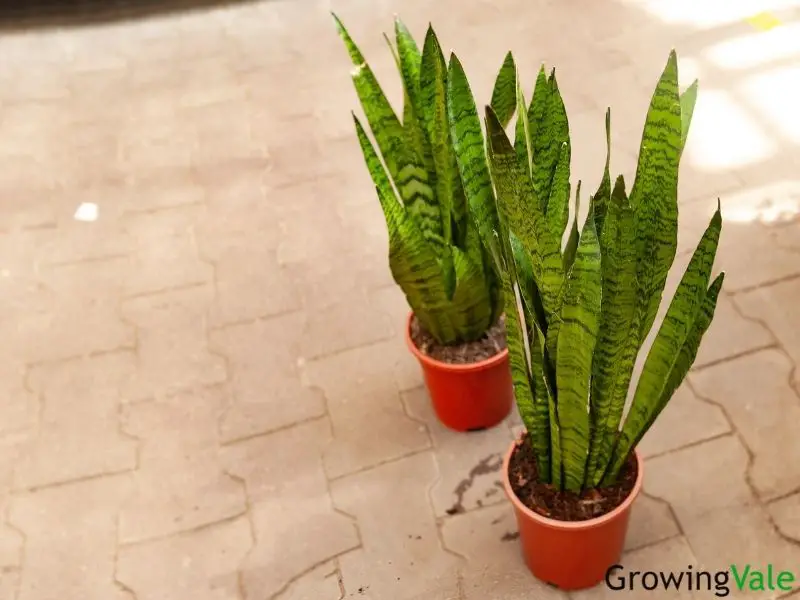
Soil
Best grown indoors in a pot with loose sandy soil, snake plants need excellent drainage. Add some sand if you can as it thrives in this substrate in its native setting. Cactus potting soils usually ensure that the nitrogen is low because succulents prefer no more than 10% nitrogen to thrive. This is an important factor if using fertilizer too.
You will need to re-pot the plant when it starts to bulge slightly at the edges of the pot or if you see roots showing. A fully rootbound pot will also need to undergo division and repotting.
Once every 2-3 years is a good frequency for repotting snake plants with fresh soil. These perennial plants should last for quite some time, provided you care for them well.
Fertilizer
The D. trifasciata certainly does not need to be fertilized as often as your tomatoes. This plant is happy with being fed once a season, especially during spring and summer when it grows quickest.
The important thing about snake plant fertilizer is that it needs a low nitrogen content. Most commercial cactus feeds should be suitable. You can also make food using your household throwaways. For example, leftover coffee grounds ensure that the soil is perfect for these plants.
Sunlight
When it comes to snake plant’s light requirements, it is known to be very tolerant of low light conditions. Its elongated, green leaves have darker green patterns, resembling a snake’s skin, which is known to change color depending on the light received. You’re more likely to see criss-cross patterning when more light is available.
The leaves change color dramatically in bright sunshine, adding striking markings, while they turn very dark in low light conditions. Be aware that the leaves may become sunburned as well, especially when exposed to scorching light.
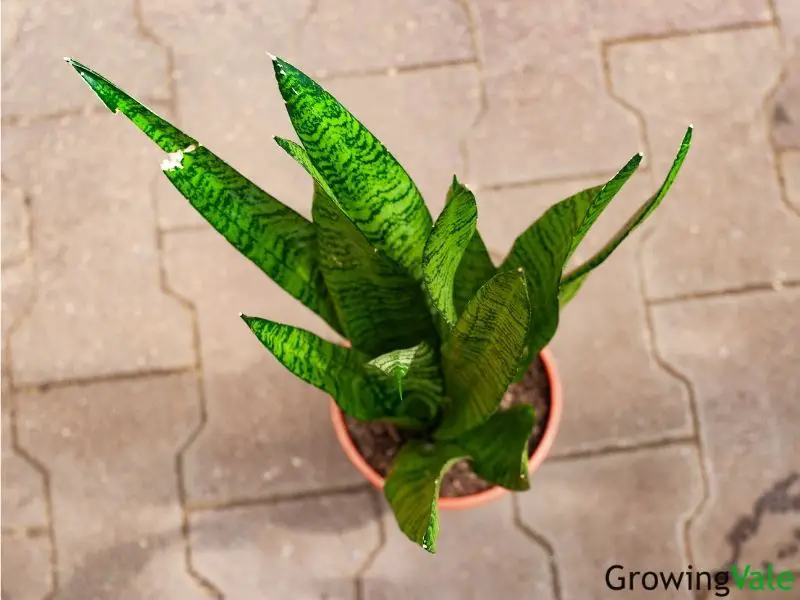
Temperature and Humidity
Snake plants can grow happily outdoors in summer, provided there is no risk of frost damage. In fact, many growers claim this is the best way to persuade the plant to flower.
The humidity for snake plants should be between 30%-40%, ideally at 40%.they need a minimum temperature of no lower than 55 degrees Fahrenheit. They are comfortable in temperatures of up to 80-85 degrees Fahrenheit (13-29 degrees Celsius).
These plants will not tolerate frost at all. Any temperature below 50 degrees Fahrenheit (10 degrees Celsius) will probably kill them off and will certainly cause their leaves to become black.
Some gardeners recommend placing a Snake Plant in a dark coloured pot to attract heat when it is placed outdoors. This may increase the temperature slightly, but the plant should ideally be kept at a range between 60 and 80 degrees Fahrenheit.
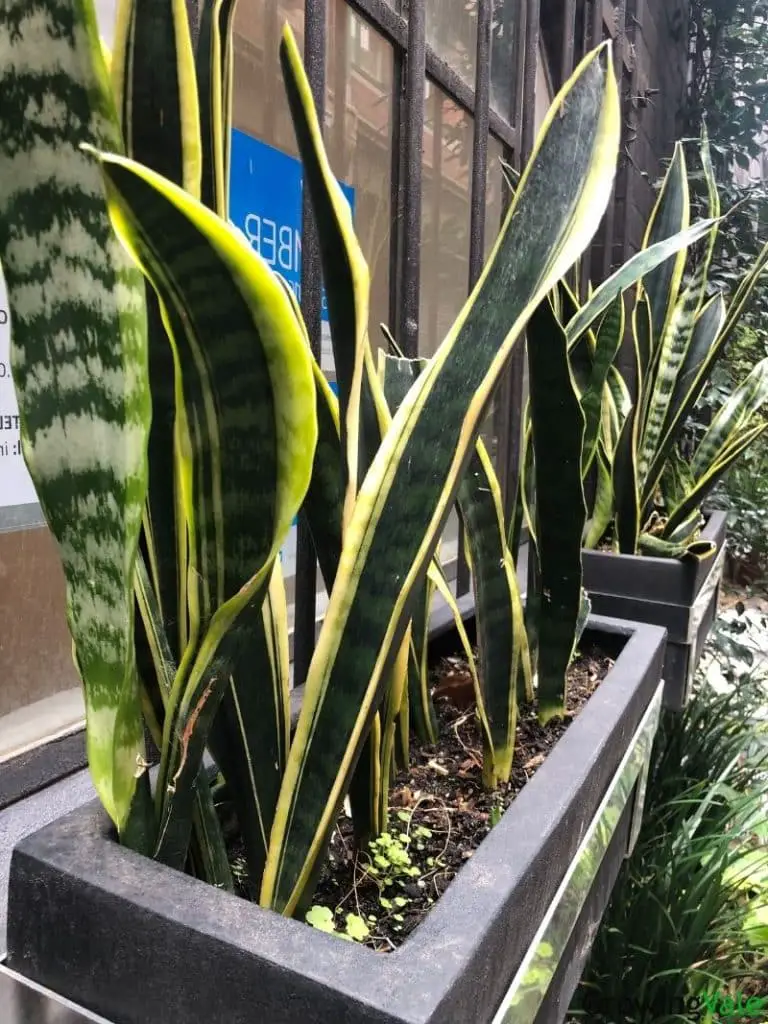
Watering
First of all, be aware that most problems with Sansevieria trifasciata occur due to overwatering. This should guide your watering routine. In the wild, this plant likes loose, well-draining soil. It should rarely have wet roots.
Choose a pot that allows water to drain efficiently and evaporate, such as a porous terracotta one with a hole at the bottom. This means the roots never have to be submerged in water. After watering, make sure to empty any saucers or catch plates that may collect excess moisture. Make sure that you do so about half an hour after watering.
It is very important that you allow the soil to dry out before you water snake plant again. This plant may need less water in winter than summer too. Watering just once a month in winter is sufficient. A good idea is to touch the topsoil around the stem to check. If it feels dry, then water. The golden rule is if in doubt, do not water at all. It is very difficult to kill off a Sansevieria by under watering, but it’s also very common for people to over water them.
Signs that you may be over watering include:
The snake plant leaves turn yellow at the edges or the texture of the leaves turns slightly soggy. They should feel quite hard and tough. The plant is called Mother-in-law’s tongue for a reason!
TIP: Observe your soil to see if there is a powdery white substance in there. Many houseplants have salts, which are a result of using tap water.
- When watering, do not just add a little. Give the plant a good soaking to try to dissolve these salts that build up.
- Then allow the excess to drain out of the pot and remove this after 30 minutes or so. This way the roots do not remain soaked and at risk of root rot.
- Another idea is to use leftover boiled water as distilled water. You can also use collected rainwater.
Pest and diseases
Common pests of this houseplant are mealy bugs and red spider mites. Both of these can be dealt with fairly simply; use a damp cloth and a mixture of dish soap and water and thoroughly wipe down the leaves and stem.
The red spider mite always leaves tell tale webs behind. As soon as you spot these, clean them off and look for little red insects on the leaves.
Repotting and Transplanting
You will know that your Viper’s Bowstring hemp needs to be repotted if the leaves are reaching the edge of your pot and causing it to strain or if you can see new roots emerging out of the base of the plant due to root bound.
It is wise to transplant every 2-3 years as a rule, because soil tends to gather salts from tap water and becomes exhausted after years of growth. Make sure you have good drainage or some sand in your mixture and your plant will thrive.
Common Varieties and Cultivars
The snake plant has over 60 varieties and grows worldwide in temperatures warm enough for it to thrive. One of the most common snake plant varieties is the Dracaena trifasciata ‘Laurentii’ type. This has yellow borders with spiked, pointed green foliage and is a favorite of gardeners all over the world.
However, there is a large selection to choose from and each type offers different variegation in the leaves. There are dwarf cultivars such as the Bird’s nest “hahnii” and the delightful cylindrical types (Sansevieria cylindrica), whose leaves resemble soft, slim, dark green pipes growing upwards.
Uses for the Snake plant
An interesting fact about Mother-in-law’s Tongue is that it produces oxygen at night, unlike most plants which produce carbon dioxide. This is why these plants are commonly known as air purifying plants.
This idea comes from an air purification study, where D. trifasciata was one of a number of plants tested by the US National Aeronautics and Space Administration (NASA). Their objective was to use Earth’s plants to help astronauts living in space have cleaner, purer air.
Initial results were promising and this plant was recognized as one which absorbed carbon dioxide. It releases oxygen at night and is able to filter certain volatile air compounds (VOCs) via its leaves.
Pollutants such as benzene, formaldehyde, and trichloroethylene were tested as well, and the Snake plant successfully removed these from the air in controlled conditions.
As a result, plant owners feel that science has recognized the benefits of placing a plant next to a computer or in a child’s bedroom to cleanse the air and provide oxygen. While it may be true that these plants are air purifiers, subsequent experiments in actual households or office environments were unable to produce the positive results in conditions achieved in the NASA study. The gardeners’ belief that this plant is an air purifier persists, although subsequent attempts to reproduce the NASA results have been inconclusive.
Please note that while there may be benefits with air purification, this plant also contains saponins, which are toxic when consumed. It is not advisable to rear this plant in areas that are easily accessed by children or pets.
In its native Africa, the leaves of this plant are used as antiseptic and anti-inflammatory. Strips of the leaves are placed on wounds like bandages. On-site use of this plant as native medicine is common.
The fiber of Dracaena ‘hanningtonii’ is traditionally used in the production of rope or textiles.
The leaves of Dracaena trifasciata are made into musical instruments, causing its name: Viper’s Bowstring hemp.
Conclusion
The snake plant is really easy to look after and this perennial succulent will give you years of pleasure as you watch it grow. The fact that it purifies your air is an extra bonus, so enjoy!
*References
Reference List:
Mark W. Chase et al., A subfamilial classification for the expanded asparagalean families Amaryllidaceae, Asparagaceae, and Xanthorrhoeaceae, https://academic.oup.com/botlinnean/article/161/2/132/2418404
Chinasa, EC, et al., Evaluation of anti-inflammatory property of the leaves of Sansevieria liberica ger. and labr. (fam: Dracaenaceae), https://www.sciencedirect.com/science/article/pii/S1995764511601958?via%3Dihub
”Close”

